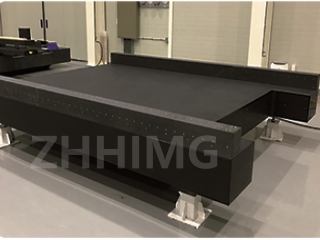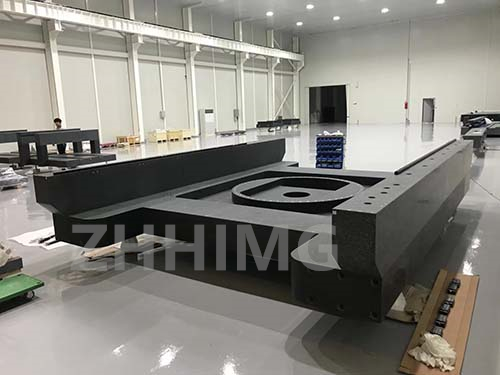Granite precision platforms, with their high rigidity, low expansion coefficient, excellent damping performance and natural anti-magnetic properties, have irreplaceable application value in high-end manufacturing and scientific research fields where precision and stability are highly demanded. The following are its core application scenarios and technical advantages:
I. Field of Ultra-precision processing equipment
Semiconductor manufacturing equipment
Application scenarios: Lithography machine workpiece table, wafer dicing machine base, packaging equipment positioning platform.
Technical value:
The coefficient of thermal expansion of granite is only (0.5-1.0) ×10⁻⁶/℃, which can resist the temperature fluctuation during the nanoscale exposure of the lithography machine (displacement error < 0.1nm in an environment of ±0.1℃).
The internal micro-pore structure forms a natural damping (damping ratio 0.05 to 0.1), suppressing the vibration (amplitude < 2μm) during high-speed cutting by the dicing machine and ensuring that the edge roughness Ra of the wafer cutting is less than 1μm.

2. Precision Grinding Machines and Coordinate Measuring Machines (CMM)
Application case:
The base of the three-coordinate measuring machine adopts an integral granite structure, with a flatness of ±0.5μm/m. Combined with the air-floating guide rail, it achieves nano-level movement accuracy (repeat positioning accuracy ±0.1μm).
The worktable of the optical grinding machine adopts a composite structure of granite and silver steel. When grinding K9 glass, the surface waviness is less than λ/20 (λ=632.8nm), meeting the ultra-smooth processing requirements of laser lenses.
Ii. Field of Optics and Photonics
Astronomical telescopes and laser systems
Typical applications:
The support platform of the reflection surface of the large radio telescope adopts a granite honeycomb structure, which is light in self-weight (density 2.7g/cm³) and has strong wind vibration resistance (deformation < 50μm under a 10-level wind).
The optical platform of the laser interferometer uses micro-porous granite. The reflector is fixed by vacuum adsorption, with a flatness error of less than 5nm, ensuring the stability of ultra-precision optical experiments such as gravitational wave detection.
2. Precision optical component processing
Technical advantages:
The magnetic permeability and electrical conductivity of the granite platform are close to zero, avoiding the influence of electromagnetic interference on precision processes such as ion beam polishing (IBF) and magnetorheological polishing (MRF). The surface shape accuracy PV value of the processed asphical lens can reach λ/100.
Iii. Aerospace and Precision Inspection
Aviation component inspection platform
Application scenarios: Three-dimensional inspection of aircraft blades, measurement of shape and position tolerances of aviation aluminum alloy structural components.
Key performance:
The surface of the granite platform is treated by electrolytic corrosion to form fine patterns (with a roughness of Ra 0.4-0.8μm), suitable for high-precision trigger probes, and the error of detecting the blade profile is less than 5μm.
It can withstand a load of over 200kg of aviation components, and the flatness change after long-term use is less than 2μm/m, meeting the precision maintenance requirements of Grade 10 in the aerospace industry.

2. Calibration of inertial navigation components
Technical requirements: Static calibration of inertial devices such as gyroscopes and accelerometers requires an ultra-stable reference platform.
Solution: The granite platform is combined with an active vibration isolation system (natural frequency < 1Hz), achieving high-precision calibration of the zero-offset stability of inertial components < 0.01°/h in an environment with vibration acceleration < 1×10⁻⁴g.
Iv. Nanotechnology and Biomedicine
Scanning probe microscope (SPM) platform
Core function: As the base for atomic force microscopy (AFM) and scanning tunneling microscopy (STM), it needs to be isolated from environmental vibrations and thermal drift.
Performance indicators:
The granite platform, in combination with pneumatic vibration isolation legs, can reduce the transmission rate of external vibrations (1-100Hz) to less than 5%, achieving atomic-level imaging of AFM in the atmospheric environment (resolution < 0.1nm).
The temperature sensitivity is less than 0.05μm/℃, which meets the requirements for nanoscale observation of biological samples in a constant temperature (37℃±0.1℃) environment.
2. Biochip packaging equipment
Application case: The high-precision alignment platform for DNA sequencing chips adopts granite air-floating guide rails, with a positioning accuracy of ±0.5μm, ensuring sub-micron bonding between the microfluidic channel and the detection electrode.
V. Emerging Application Scenarios
Quantum computing equipment base
Technical challenges: Qubit manipulation requires extremely low temperatures (mK level) and an ultra-stable mechanical environment.
Solution: The extremely low thermal expansion property of granite (expansion rate < 1ppm from -200℃ to room temperature) can match the contraction characteristics of ultra-low temperature superconducting magnets, ensuring the alignment accuracy during the packaging of quantum chips.
2. Electron Beam Lithography (EBL) system
Key performance: The insulation property of the granite platform (resistivity > 10¹³Ω · m) prevents electron beam scattering. Combined with the electrostatic spindle drive, it achieves high-precision lithography pattern writing with a nanoscale line width (< 10nm).
Summary
The application of granite precision platforms has extended from traditional precision machinery to cutting-edge fields such as nanotechnology, quantum physics, and biomedicine. Its core competitiveness lies in the deep coupling of material properties and engineering requirements. In the future, with the integration of composite reinforcement technologies (such as graphene-granite nanocomposites) and intelligent sensing technologies, granite platforms will break through in the directions of atomic-level accuracy, full-temperature range stability, and multi-functional integration, becoming the core basic components supporting the next generation of ultra-precision manufacturing.
Post time: May-28-2025
